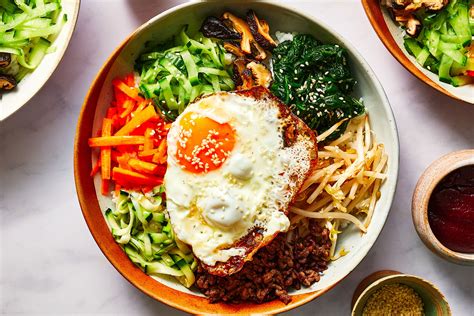Korean Bibimbap Recipe: A Delicious and Healthy Meal
Bibimbap, meaning "mixed rice" in Korean, is a vibrant and flavorful dish that's both healthy and satisfying. This recipe will guide you through making an authentic and delicious bibimbap at home. Get ready to impress your family and friends with this colorful culinary masterpiece!
Ingredients:
This recipe serves 2-3 people. You can easily scale it up or down depending on your needs.
For the Rice:
- 1 cup short-grain white rice
- 1 ¼ cup water
For the Vegetables:
- 1 cup spinach, blanched and chopped
- ½ cup bean sprouts, blanched
- ½ cup julienned carrots, sautéed
- ½ cup sliced mushrooms, sautéed
- ½ cup zucchini, julienned and sautéed
- 1 small onion, thinly sliced and sautéed
For the Protein:
- 1 cup thinly sliced marinated beef (see marinade recipe below) – You can substitute with tofu, chicken, or even just a fried egg for a vegetarian option!
- 1 tbsp sesame oil
For the Sauce (Gochujang):
- 2 tbsp Gochujang (Korean chili paste)
- 1 tbsp soy sauce
- 1 tbsp rice vinegar
- 1 tsp sesame oil
- 1 tsp sugar
- ½ tsp minced garlic
For the Garnish:
- 1 egg, fried sunny-side up
- 1 tbsp sesame seeds
- 2-3 green onions, thinly sliced
- Kimchi (optional)
Instructions:
Preparing the Rice:
- Rinse the rice under cold water until the water runs clear.
- Combine the rice and water in a saucepan. Bring to a boil, then reduce heat to low, cover, and simmer for 15-20 minutes, or until all the water is absorbed.
- Fluff the rice with a fork and set aside.
Marinating and Cooking the Beef (Optional):**
- If using beef, marinate the thinly sliced beef in 1 tbsp soy sauce, 1 tsp sesame oil, ½ tsp minced garlic, and a pinch of black pepper for at least 30 minutes (or longer for a deeper flavor).
- Heat 1 tbsp sesame oil in a pan over medium-high heat. Add the marinated beef and cook until browned and cooked through.
Assembling the Bibimbap:
- Divide the cooked rice into bowls.
- Arrange the cooked vegetables (spinach, bean sprouts, carrots, mushrooms, zucchini, and onion) on top of the rice.
- Place the cooked beef (or your chosen protein) on top of the vegetables.
- Top with a fried egg.
- Drizzle generously with Gochujang sauce.
- Sprinkle with sesame seeds and sliced green onions.
- Add kimchi, if desired.
Making the Gochujang Sauce:
- In a small bowl, whisk together the Gochujang, soy sauce, rice vinegar, sesame oil, sugar, and garlic until smooth. Adjust the amount of each ingredient to your taste preference. More Gochujang for spicier sauce!
Tips and Variations:
- Customize your vegetables: Feel free to add other vegetables you enjoy, such as bell peppers, cucumbers, or even sweet potatoes.
- Experiment with protein: As mentioned before, tofu, chicken, or shrimp are all great alternatives to beef.
- Make it vegetarian: Simply omit the meat and add extra vegetables or a fried tofu patty.
- Add some crunch: Toasted sesame oil adds a nice nutty flavor and aroma. You can also add some crushed nuts or seaweed flakes for extra texture.
Enjoy your homemade Korean Bibimbap! This recipe is a great way to showcase the beauty and variety of Korean cuisine. Don't be afraid to experiment and make it your own! Remember to share your creations and tag us! #bibimbap #koreanfood #homecooking
